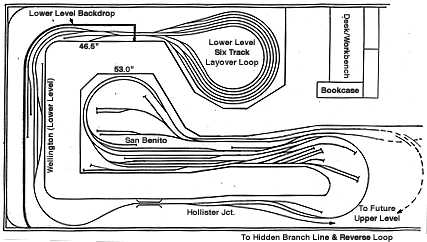
The HO scale Montgomery and San Joaquin Railroad depicts a 1950 to 1960 era, single track subsidiary of the Southern Pacific Railroad across California's Coast Range, the San Joaquin Valley, and the Sierra Nevada Mountains from San Jose to south central Nevada. South from San Jose the line parallels parent Southern Pacific's Coast Route as far as Gilroy, then turns east toward the San Joaquin Valley. At Hollister Junction a line branches off toward Hollister, where it crosses the SP's Hollister Branch before continuing on to Salinas where it rejoins the SP Coast Route.
The modeled portion extends from Wellington (just southeast of Gilroy), through San Benito, to Kaiserville in the San Joaquin Valley (all fictitious cities). Hollister Junction is between Wellington and San Benito.
The partially completed, walk-in, point-to-point layout, with hidden staging yards/reversing loops occupies about 60% of a 15' x 40' building.
Planning for the layout began about 1984. Room preparation
began in 1985 and 45 feet of continuous backdrop was installed
in 1986. Benchwork construction began in August 1987 and enough
track was installed to begin limited operation in January 1988.
The far end of the layout will eventually have two
levels, one at 46.5 inches above the floor and the other at about
60 inches. The lower level (Wellington) was mostly finished in
1989 with additional details added in 1991-92. Wellington has
two passing tracks (one long and one short), a mail and express
track, and three industrial sidings.
The mainline between Wellington and San Benito has
a 1.8% grade. It includes a passing track and a junction for the
Hollister Branch. This section of the layout is currently without
scenery.

Much of the visible track in the center "peninsula"
of the layout was installed in 1990 but somewhat reworked in 1993
and significantly revised in early 1995. The height of this part
of the layout is 53 inches.
The San Benito passenger station has three through
tracks, a mail and express track, and two storage tracks. The
M&SJ provides local/commuter service between San Benito and
San Francisco via San Jose, as well as through passenger service
to the San Joaquin Valley and beyond. The San Benito freight yard
has three through tracks, a storage track, and two industrial
tracks. (The Hollister Branch reversing loop and extra storage
track are underneath San Benito.)
Part of the center peninsula is only about 26 inches
wide. This was primarily dictated by the width of the hidden reversing
loops across the aisle (the outermost loop has a radius of 34
inches). Where the mainline enters and leaves the peninsula the
tracks are less than a foot apart horizontally but are at different
elevations. In between is the track for a short branch that will
eventually go to another industrial area. This track is also the
tail of a wye for turning cars and locomotives at San Benito.
(A track that provided a reversing loop at San Benito was removed
in favor of the wye. The reversing loop required locomotives or
trains to go down the hill toward Wellington followed by an uphill
backup move.)
The area inside the large, double track curve opposite
the San Benito station is the east end industrial/business area
of San Benito. It includes a second mail and express/team track,
a Union Ice Company refrigerator car icing track, and three industrial
sidings.
Two industrial tracks, a caboose track, a four-track
engine terminal, and a switch lead for the west end of the freight
yard (albeit through a crossover) were added at the west end of
the San Benito yard in late 1994.
Installation of the scenery and buildings in the
San Benito city area and the engine terminal area is nearly complete.
Eventually the mainline track will be extended to
the upper level (Kaiserville) and a second hidden staging/reversing
yard directly above the lower level reversing loops. This track
extension will allow completion of the scenery along the wall
between Wellington and San Benito.
The biggest drawback of the layout's design is the
aisle width which narrows to barely 20 inches at one point. This
was the result of the 14 foot 4 inch interior width of the room,
a minimum width of 24 inches for the layout sections, and a minimum
radius of 30 inches. Narrower shelves and stub end staging yards
could have eliminated most of this problem but I wanted reversing
loops to turn passenger trains. However, if I were to redesign
the layout I'd make provision for wider aisles.
The home was originally owned by Leighton Keeling,
a model railroader, member of Whit Tower's Alturas and Lone Pine
Operators, and president of the National Model Railroad Association
(NMRA) in the early 1960s. He and his son originally built the
15' x 40' building in 1962 to house a model railroad that was
never built. Leighton Keeling died in 1979 and we purchased the
home from his estate in 1980.
The layout was on the Santa Ana Special layout tour
as part of the Long Beach Limited NMRA National Convention in
July 1996. If you would like to arrange for a visit please contact
LJAMES1@ix.netcom.com.
The track schematic is in three sections covering Wellington, Hollister Junction, and San Benito.

© 1998 ljames1@ix.netcom.com